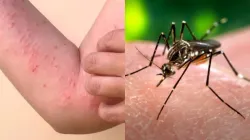Chikungunya's new variant wreaks havoc in Pune; know causes, symptoms and ways to prevent this viral disease
Know about the latest on Chikungunya's new variant causing a surge in Pune. Be aware of its causes, symptoms, and effective prevention methods to stay protected.

A new variant of the Chikungunya virus has recently emerged in Pune, causing widespread concern due to its rapid spread and the severity of its symptoms. Due to this new variant, many health-related problems are also arising in the body of people. About 2,000 infections have been recorded due to this virus. As this mosquito-borne viral disease continues to wreak havoc, it is essential to understand its causes, symptoms, and preventive measures.
What is Chikungunya?
Chikungunya is a viral infection transmitted by Aedes mosquitoes, which are also responsible for spreading dengue and Zika viruses. The virus causes fever and severe joint pain, often leading to prolonged discomfort. While it is not usually life-threatening, the new variant has increased fears due to its more aggressive nature.
Causes of Chikungunya:
The primary cause of Chikungunya is the bite of an infected Aedes mosquito, typically Aedes aegypti and Aedes albopictus. These mosquitoes breed in stagnant water and are most active during the daytime. The spread of the new variant in Pune is likely due to the following factors:
- It increased mosquito population due to monsoon rains and improper waste management.
- Urbanization and overcrowding, have created favorable conditions for mosquito breeding.
- Climate changes, particularly warmer temperatures, have allowed mosquitoes to thrive in a wider geographic area.
Symptoms of Chikungunya:
The symptoms of Chikungunya usually appear 4-8 days after being bitten by an infected mosquito. The new variant has shown more intense symptoms, making it harder for patients to recover quickly. Common symptoms include:
- High fever (often over 102°F)
- Severe joint pain (especially in wrists, knees, and ankles)
- Muscle pain
- Headache
- Fatigue and weakness
- Rash (on limbs and torso)
- The joint pain may persist for weeks or even months, severely impacting mobility and quality of life.
Prevention of Chikungunya:
Preventing Chikungunya involves reducing mosquito exposure and breeding. Here are some key measures to protect yourself and your community:
- Eliminate stagnant water: Regularly empty water containers, flower pots, and other places where water can accumulate.
- Use mosquito repellents: Apply repellents on exposed skin, especially during the early morning and late afternoon when mosquitoes are most active.
- Wear protective clothing: Long-sleeved shirts and pants help minimize skin exposure.
- Install mosquito nets and screens: Use these at home to keep mosquitoes out.
- Community action: Participate in neighborhood cleanup efforts to reduce mosquito breeding grounds and report large areas of stagnant water to authorities.
- Public health measures: Municipal efforts to control the mosquito population through spraying insecticides in affected areas are critical in stopping the spread.
The new variant of the Chikungunya virus in Pune has become a serious public health concern. By understanding the causes, recognizing the symptoms early, and taking proactive steps to prevent mosquito bites, individuals and communities can play a vital role in curbing the spread of this viral disease. Staying informed and vigilant is essential to protect public health during this outbreak.
(This article is for general information. Please consult a medical professional for personalized advice on any remedy.)
ALSO READ: Mpox vs Childhood Common Illnesses: Know the key differences and when to worry
